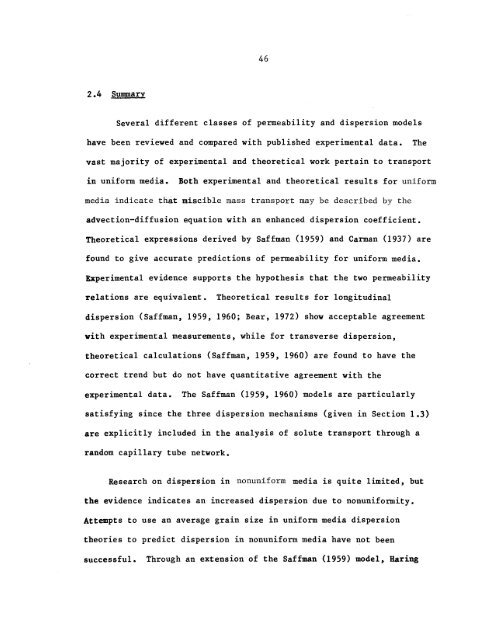longitudinal dispersion in nonuniform isotropic porous media
longitudinal dispersion in nonuniform isotropic porous media
longitudinal dispersion in nonuniform isotropic porous media
Create successful ePaper yourself
Turn your PDF publications into a flip-book with our unique Google optimized e-Paper software.
2.4 SUmmary<br />
46<br />
Several different classes of permeability and <strong>dispersion</strong> models<br />
have been reviewed and compared with published experimental data. The<br />
vast majority of experimental and theoretical work perta<strong>in</strong> to transport<br />
<strong>in</strong> uniform <strong>media</strong>. Both experimental and theoretical results for uniform<br />
<strong>media</strong> <strong>in</strong>dicate that miscible mass transport may be described by the<br />
advection-diffusion equation with an enhanced <strong>dispersion</strong> coefficient.<br />
Theoretical expressions derived by Saffman (1959) and Carman (1937) are<br />
found to give accurate predictions of permeability for uniform <strong>media</strong>.<br />
Experimental evidence supports the hypothesis that the two permeability<br />
relations are equivalent. Theoretical results for <strong>longitud<strong>in</strong>al</strong><br />
<strong>dispersion</strong> (Saffman, 1959, 1960; Bear, 1972) show acceptable agreement<br />
with experimental measurements, while for transverse <strong>dispersion</strong>,<br />
theoretical calculations (Saffman, 1959, 1960) are found to have the<br />
correct trend but do not have quantitative agreement with the<br />
experimental data. The Saffman (1959, 1960) models are particularly<br />
satisfy<strong>in</strong>g s<strong>in</strong>ce the three <strong>dispersion</strong> mechanisms (given <strong>in</strong> Section 1.3)<br />
are explicitly <strong>in</strong>cluded <strong>in</strong> the analysis of solute transport through a<br />
random capillary tube network.<br />
Research on <strong>dispersion</strong> <strong>in</strong> <strong>nonuniform</strong> <strong>media</strong> is quite limited, but<br />
the evidence <strong>in</strong>dicates an <strong>in</strong>creased <strong>dispersion</strong> due to <strong>nonuniform</strong>ity.<br />
Attempts to use an average gra<strong>in</strong> size <strong>in</strong> uniform <strong>media</strong> <strong>dispersion</strong><br />
theories to predict <strong>dispersion</strong> <strong>in</strong> <strong>nonuniform</strong> <strong>media</strong> have not been<br />
successful. Through an extension of the Saffman (1959) model, Har<strong>in</strong>g

















